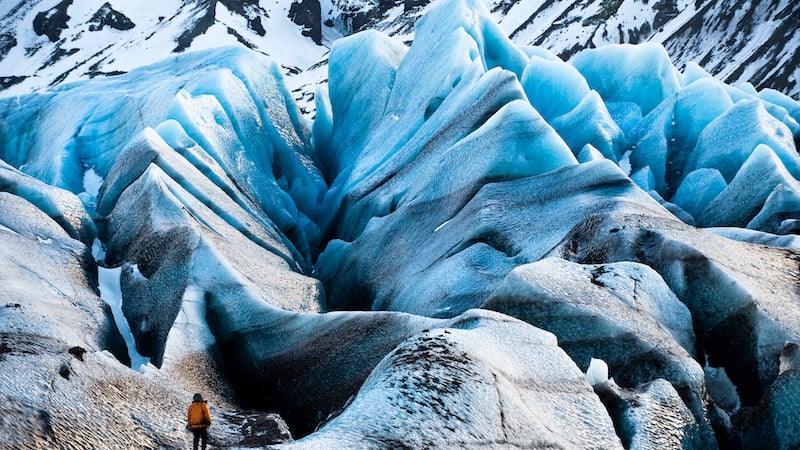
To crassly understate it, the weather on the Eastern Seaboard has been a bit unpleasant. Hurricane Sandy was a disaster the likes of which public transit in New York City has never seen, and the crises of electricity and gas all over the region may continue well into November. Always ready to lighten the mood and lift our spirits, The Onion ran the following story: “Nation Suddenly Realizes This Just Going to Be a Thing That Happens from Now On.” As if responding to the challenge, a Nor’easter promptly hit on the night of November 7th. The satirical newspaper’s droll acceptance of climate change, however, isn’t yet shared by everyone. Enter Chasing Ice, the most recent in a wave of documentaries dead set on changing the national perception of the weather.
It’s an uphill battle. This most recent cycle of presidential debates was the first since 1988 without a single mention of climate change. It has been six years since An Inconvenient Truth won two Oscars and got everyone talking, at least temporarily. Despite significant majorities of scientists in agreement, the debate has been portrayed as one of hypotheticals on equal footing. For an environmentalist like James Balog, this must be remarkably frustrating. The battle is now one of perception alone, an endeavor to convince the public that something is really going on. Al Gore’s project was only the first step.
Balog, while trained as a scientist, has had built an impressive career as an environmental photographer. Once convinced of climate change himself (which did not happen overnight), he set out to prove its effects to the world. The canary in the coal mine for the crisis is the Arctic. The collapse of glaciers in Alaska, the melting of the Greenland ice sheet and the thawing of permafrost are the most immediately visible effects of rising temperatures. Yet because they are incredibly far away from the world’s most populated areas, no one is seeing the change firsthand. Balog’s Extreme Ice Survey, founded in 2007, is the first major effort to photograph and video the drastic changes to the landscape. He and his team placed cameras around glaciers in Greenland, Alaska, Iceland and Montana, setting them up to photograph the ice each hour of daylight. They maintained them for years. Chasing Ice is the story of EIS.
Director Jeff Orlowski followed Balog and his team across the frozen North, from the project’s earliest days in Iceland and on to the vast glaciers of Greenland. Yet the images of the project itself are by far the most compelling feature of Chasing Ice, rather than those captured by the filmmaker. Balog’s photographs are stunning, crisp compositions in white and blue that ring with the sharp clarity of the Arctic. Yet this is about much more than the simple pleasure of enjoying the view. As his project advances, the images he is able to capture become more implicitly menacing. The mission of EIS is to document rapid change and destruction, and it could not have been more successful.
The time-lapse sequences, at last assembled from thousands of individual photos, will take your breath away. Like Balog’s still photographs of the Arctic earlier in the film, these high-resolution achievements hold an oceanic splendor. They play more like disaster scenes from Roland Emmerich’s movies than the quiet masterpieces of polar art. Enormous blocks of ice break off from the glaciers and drift into the water, a process called “calving.” This is happening so quickly to some glaciers that Balog had to pivot his cameras to follow the ice retreating mile after mile away.
The greatest single achievement, which Orlowski also holds until the end, is a video recording of the largest calving ever witnessed. Balog’s assistants had to wait overlooking a glacier for more than two weeks, but the final footage is worth it. A monstrous sheet of ice, equivalent in size to Lower Manhattan, takes just 75 minutes to crack away from the mother glacier. Towering ice bergs, larger than any of New York City’s skyscrapers, rise into the air and then plunge back down into the depths. It seems as if the planet itself is convulsing before our eyes.
These unforgettable images make Chasing Ice instantly more memorable than some prior films in the genre, An Inconvenient Truth in particular. Our awe at such impossibly tumultuous events inspires in a single moment more than any number of Gore’s graphs. Yet, like Davis Guggenheim’s zeitgeist-setting documentary, Chasing Ice has similar difficulties with its human component. Orlowski charts the trials and tribulations of the EIS crew alongside those of the glaciers and, while it is never quite as grating as Truth’s campaign-video narrative, it can’t avoid falling flat. Balog’s dedication, through multiple knee surgeries, is admirable. Photography nerds will be fascinated by the sheer difficulty of shooting in such extreme environments, and perhaps thrilled by the ingenuity the EIS team brought to solving these problems. Yet on the whole, the triumph of the human spirit in Chasing Ice is nothing compared to the tumbling glaciers.
Then again, who knows? Films like Chasing Ice and An Inconvenient Truth are made to spread the word. Other non-fiction works, like Sweetgrass and Leviathan abandon human narratives for a more immediate portrayal of nature, yet they also lose the opportunity to drive home the immediacy of environmental issues. Chasing Ice is solid, but it is necessary viewing for the citizen rather than the soul. And with all of those glaciers melting down, filling up the oceans and therefore indirectly ripping our beaches down by storm, that seems to be exactly what we need.
The Upside: I’m reasonably certain every possible shade of blue makes an appearance in Balog’s photographs.
The Downside: You might spend the rest of your day fairly convinced the world will be ending tomorrow.
On the Side: The original song composed for the film “Before My Time,” is sung by Scarlett Johansson.
